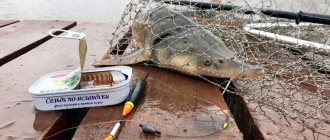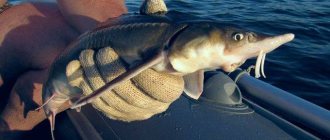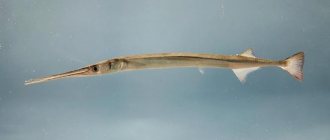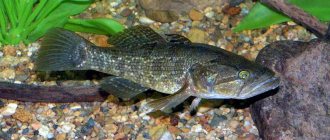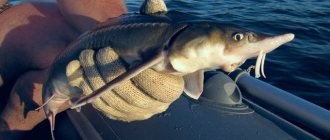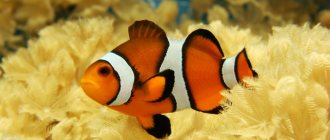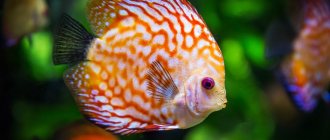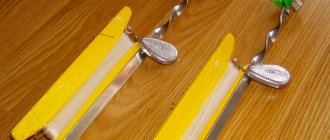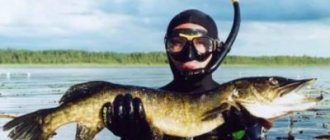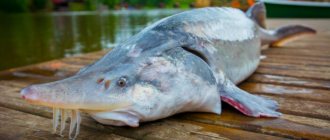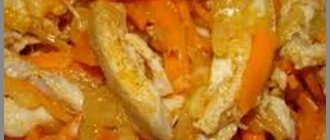Sterlet has always occupied a special place in Russian cuisine: in the recent past, it was impossible to imagine a single holiday table without it. But nowadays, due to thoughtless fishing and poaching, it is extremely rare in nature. Therefore, people who want to please themselves with treats made from its delicious meat are willing to pay a fairly high price for fresh fish. At the same time, the technology for growing it in artificial conditions is not difficult to master, as a result of which breeding sterlet as a business can very well bring substantial profits to the entrepreneur.
Why grow sterlet?
Sterlet is the smallest representative of the sturgeon family. In its natural environment, it prefers deep freshwater rivers of Siberia, the Volga-Caspian and Azov-Black Sea basins. The fish lives on average 20–25 years, reaching a length of 60–80 cm and a weight of 2–3 kg, although there are specimens with a body of 120 cm and a weight of 15 kg. Sterlet is characterized by early maturation - males are ready to breed at the age of 4–5 years, and females at 6–7 years. Farmers breed it for products such as:
- Fresh fish. Delivered live, chilled or frozen. Wholesale clients pay 700–800 rubles per kilogram of ungutted sterlet;
- Black caviar. More often associated with sturgeon, but growing sterlet for caviar is no less profitable - the fish go to spawn earlier, and the product costs up to 40,000 rubles / kg;
- Processed fish. If you buy the necessary equipment, you can produce smoked or dried sterlet. Its cost reaches 1200–1600 rubles/kg;
- Soup set. Heads, tails, fins and other offal that remain after cutting fish can also be sold. People buy them for 400–500 rubles/kg.
The main value of sterlet is culinary: sturgeon meat is traditionally considered one of the most expensive delicacies. The fish is fried, stuffed or baked in the oven, fish soup, soups and aspic are prepared from it, and used as a filling for pies.
Sterlet in an aquarium: keeping, feeding, compatibility
Share this article:
Many people think that sterlet looks more appropriate on the dining table than in an aquarium. But in vain, because this rare and amazing fish has a spectacular appearance and interesting behavior. Guests will be pleasantly surprised to see such an unusual inhabitant of the aquarium.
Description
Sterlet (lat. Acipenser ruthenus) is the smallest representative of the sturgeon family - in nature it grows up to 1 meter, and in an aquarium it can grow up to 60-70 cm. Mainly distributed in the European part of Russia, most often found in the basins of large reservoirs: the Volga , Yenisei, Ob, Black Sea, Don, Dnieper, etc. In the past it was very common, but due to uncontrolled fishing, destruction of spawning grounds and regulation of river flow, its population has been greatly undermined, and it can rarely be found in the natural environment.
This fish is curious for its structure and appearance: its scales are collected in rows of bony plates - bugs, which are especially prickly and noticeable in juveniles. The caudal fin is heterocercal (the upper blade of the fin is longer than the lower) and is very similar to the tail of a shark. Since the sterlet is a bottom-dwelling fish, it has a lower mouth, which allows it to pick up food from the bottom. Thus, it takes the place of a catfish in the aquarium.
The color of the sterlet is dark gray, with a white belly and light rows of bugs. It is darkest and most contrasting in young fish, and begins to fade with age.
In the aquarium it behaves actively, scours the bottom in search of food, and if the area is insufficient, it can swim in circles around the aquarium.
Sturgeon fish are considered living fossils because over millions of years of evolution their structure and appearance have changed little.
Content
Among the sturgeon species, the sterlet takes root best in the aquarium, but is quite finicky in keeping, so it is clearly not for beginners.
It is better not to use wild-caught animals as pets, as they may not survive transfer to captivity well or be carriers of various diseases, including helminth infections.
Buying sterlet for an aquarium in a store will also be quite problematic, because it is not particularly popular among aquarists. One option is to purchase fry from fish hatcheries. They will be easier to move into the aquarium and, most likely, will already be accustomed to artificial food.
An excellent option for keeping sterlet is a spacious pond.
In nature, sterlet lives in cool water bodies with fast currents and a high oxygen content in the water. In order for the fish not to get sick and feel comfortable, it is necessary to get as close as possible to these conditions:
- large aquarium volumes - from 300 l;
- a powerful pump will help create active water circulation in the aquarium, simulating the flow of a river;
- filtration and aeration are required;
- optimal water temperature: up to 20-22 °C;
- weekly water changes 25%;
- acidity: 6.5-8.5 pH;
- hardness: 6-25 dGH;
- the fish is active and mobile, so the container must be equipped with a lid to prevent jumping out of the aquarium.
Sturgeons also have albinos.
Sterlet does not need shelter or vegetation; the design option is to create its biotope, a rocky bottom and a couple of elodea branches. You can use fine gravel, sand and medium pebbles as soil.
The most important condition for keeping sturgeon is constant water temperature. Sudden changes are poorly tolerated. Some breeders equip their containers with special equipment to prevent overheating. Aeration is also important; insufficient oxygen is the main cause of fish death in home aquariums.
Like other sturgeon, sterlet produces a lot of mucus, so a powerful mechanical and biological cleaning system is required.
An unexpected outbreak of nitrites and nitrates can kill the inhabitants of the aquarium.
Feeding
In nature, the sterlet is a predator. It feeds on fish fry, caviar, worms, bloodworms, and insect larvae. It feeds most actively in the evening.
In the aquarium, it readily eats all types of live and frozen food:
- bloodworm;
- Artemia;
- tubifex;
- shellless shrimp;
- pieces of fish;
- squid;
- sinking dry fish food pellets.
Compatibility
Cold-water fish are chosen as neighbors for sterlet:
Some aquarists manage to keep sterlet with tropical fish species, choosing a temperature that is comfortable for all inhabitants.
Small fish that the sterlet can swallow are not suitable as neighbors. Tropical fish will get sick at low temperatures, so they are also not suitable as neighbors.
An ancient predator and now a rare inhabitant of the rivers of the European part of Russia, listed in the Red Book. If kept properly, sterlet can stand out even against the backdrop of bright overseas exotics.
aquariumguide.ru
Methods of growing sterlet
Practice shows that growing sterlet at home can be effective due to its ability to successfully adapt to the artificial environment. Depending on the volume of fish products expected to be received and how much money the business entrepreneur plans to invest in the business, you can choose the most suitable method of maintaining it:
- In a natural environment. If there is a small reservoir on the site, you can start breeding sterlet in the lake. It is cleaned, populated with insects and plants, and fry are released here in the spring. The depth of the reservoir should prevent freezing;
- In the ponds. To grow sterlet, you can dig one or several pools with an area of up to a hectare and a depth of 3–4 m. In this case, you need to take care of supplying them with clean water, purchase filters and aerators;
- In the cages. The technology of breeding sterlet in cages is used mainly in warm regions. To develop a farm, you need access to a river or lake: to get it, you will have to participate in auctions held by the local administration;
- In aquarium. The method of breeding sterlet in an aquarium can hardly be called industrial: it is rather intended to satisfy the interest of amateurs. Even in a container of 400–500 liters only 2–3 adult specimens will fit;
- In an artificial environment. The most expensive and most effective method is breeding sterlet in a RAS. An indoor farm can maintain optimal conditions for fish growth at any time of the year.
How to choose food?
Sterlet feeding is done at the bottom of the reservoir. This condition corresponds to how fish of this species feed in nature. Ready-made food for sturgeon is available for sale. If necessary, you can prepare it yourself.
Food for sterlet should consist of:
Sturgeon fry are characterized by uneven development. A fifth of the total grows faster than others, as a result they become stronger and take most of the food for themselves.
The following are suitable for feeding young fish of this species:
- Daphnia;
- insect larvae;
- small crustaceans;
- fry of fresh fish species.
When they grow up, you can add shells to their diet. Crustaceans are the main food of adult sterlet. You should not give your fish too much food as this may harm them. It is easier to regulate the dose when purchasing special food. The packaging indicates how much food is needed for a certain number of fish, depending on their age.
If the fish are kept in a pond outside, and there are no plans to move them in winter, then feeding stops with the onset of frost, and the pond is limed. During the hibernation period, the weight of the fish does not change. In the spring, feeding resumes.
Business Features
Sterlet feels comfortable in reservoirs of different climatic zones, but to achieve maximum development speed it needs clean, oxygenated water with a temperature of 20–22°C and constant access to high-calorie feed. It is difficult to maintain such conditions constantly when breeding sterlet in a pond, and therefore there is no alternative to RAS for industrial fish farming within a small business.
A closed water supply installation is a complex of artificial pools in which automation regulates the temperature and chemical composition of the water. This allows fish to be housed at a density ten times higher than in cages and natural reservoirs. Such equipment costs at least 400 thousand rubles, but its high price is one of the few disadvantages of the business. There are many more advantages here:
- The fish is not demanding on living conditions. Moreover, when grown at home, sterlet gains weight much faster than in nature;
- Mastering the technology of breeding sterlet will not be a problem even for a beginner - today there are many materials and manuals on this topic;
- Modern installations automate 90% of livestock care. Therefore, when breeding sterlet at home, daily work will take a maximum of 3–4 hours;
- Sturgeon are in great demand. There is sterlet or dishes made from it on the menu of every decent restaurant and on the counter of every fish store;
- The business is no less profitable than growing and breeding sturgeon at home. Sterlet products are only 10–15% cheaper;
- In Russia, no more than two dozen farms deal with sterlet on an industrial level. Therefore, an entrepreneur need not be afraid of competition and dumping.
mini farm at home
To start such a profitable business as sturgeon breeding, a mini farm is best suited. In this article we will tell you what is required to create such an enterprise, where to start, and what kind of profit you can expect.
The content of the article:
What is needed to breed sturgeon?
Breeding sturgeon at home as a business is not too complicated, but profitable. At the same time, you can create an enterprise even in a small space.
List of what you will need first:
- whitebait;
- tanks;
- heated room;
- feed;
- optional equipment.
Where to get sturgeon fry
It is almost impossible to obtain sturgeon fry at home, since the full development of the embryo requires specific conditions, which are quite difficult to achieve without special equipment and appropriate skills. It is best to purchase fry from large fisheries that breed sturgeon. The average weight of the fry should be about five grams. You should not save on fry - the growth rate and productivity of the fish, and, accordingly, profit, depend on the quality of the fry.
Containers for growing sturgeon
At the initial stage, a plastic (polypropylene) container with a diameter of about 2-3 meters and a depth of 80 centimeters to 1 meter is sufficient. You can order such a tank from a swimming pool manufacturing company. This capacity will allow growing about 800-1100 kilograms of fish per year. You can also use a frame pool of similar dimensions, but in this case it is important to ensure the reliability of the structure. It is better to avoid using cheap Chinese options.
Sturgeon breeding room
Sturgeon cultivation can be established even in a city apartment. To organize an enterprise, a room with an area of 30-40 square meters with the ability to maintain a constant temperature of 22-25 degrees Celsius is sufficient. The premises must be equipped with water supply and sewerage.
What to feed sturgeon
The best solution is to purchase special food for sturgeon from companies that breed these fish species. Once you gain experience, you will be able to produce it yourself.
Since the sturgeon is a bottom-dweller and seeks food using its sense of smell, the food must have an attractive smell to the fish and be of sufficient weight to sink rather than float on the surface.
As a rule, sturgeon are given high-calorie feed containing up to 50 percent protein, about 25 percent fat and at least three percent fiber (a fiber content of four to five percent is considered optimal). Additionally, lysine and phosphorus are added to the feed. Moreover, each age group of fish requires special food.
What equipment is needed to grow sturgeon?
Since in the tanks in which the sturgeon will live, it is necessary to ensure filtration, aeration and water purification, as well as maintain a constant temperature of about 20 degrees Celsius, you will need:
- filter;
- pump;
- compressor;
- oxygen generator;
- thermometers;
- oximeter;
- heating system (you can use a heating cable that is used in heated floors).
In addition, automatic feeders will be a worthwhile purchase, which will significantly simplify fish care and provide significant time savings.
How to breed sturgeon
The conditions for breeding sturgeon are simple: it is necessary to constantly monitor the proper operation of the equipment, the purity of the water, and indicators of temperature and oxygen saturation. The water in the tanks must be transparent and visible to the bottom, so it is necessary to promptly remove sediment and waste from the tanks. The average density of fish stocking in tanks should not exceed 60 kilograms of weight per square meter.
Sturgeon is grown to a weight of 500-650 grams, after which it is caught for sale. It is not worthwhile to grow larger fish, as it will be much more difficult to sell. The growth rate of sturgeon is uneven - some individuals (usually about 20 percent of the total) can reach their target weight in five months, while the majority reach this weight in about seven months. This happens because larger and stronger individuals push small fish away from food, taking most of it for themselves.
The grown fish should be removed evenly, and the supply of fry should be uniform.
Who to sell sturgeon fish to?
Sturgeon is a delicacy that is in high demand all over the world. You can sell farmed fish through supermarkets and small fish shops, but the easiest way is to sell it to restaurants. According to statistics, a small restaurant on average consumes from 55 to 65 kilograms of sturgeon monthly.
Profitability of sturgeon breeding
Purchasing the necessary equipment will cost approximately three thousand dollars. Rent of a suitable premises costs $200-300 per month. Initial costs for feed and utilities are about 400-500 dollars. The cost of a high-quality sturgeon fry is about two euros, so you will need to spend about 600-700 euros on a fry. The total cost will be no more than five thousand dollars.
The average income from the sale of one sturgeon is about six dollars. Thus, the net profit will be about 3.5 thousand dollars per year, excluding the sale of caviar. The payback period for the enterprise is up to one and a half years.
In general, there is nothing particularly difficult in breeding sturgeon fish, and such a business brings quite high profits. In addition, if things go well, the enterprise can easily be expanded.
Video on the topic:
Did you like the article? Share with your friends:
p-business.ru
Where to breed sterlet?
A closed water supply installation is a fairly large structure weighing several tens of tons. Contrary to popular belief, it simply will not fit in an apartment, and therefore it is better for a beginner to study the prospects of breeding sterlet on a personal plot: for these purposes, you can adapt a garage, barn, basement or heated polycarbonate greenhouse. If we are talking about industrial-scale production, it is necessary to rent a separate spacious room - for example, to grow two tons of fish per cycle, an area of 250 m² is needed. Things to consider:
- To set up a farm you need a heated capital room. Otherwise, you will have to spend a lot of energy heating water in winter;
- There must be access to running water or a well on the property. In swimming pools, approximately 5% of the water will have to be replaced every day;
- You will need an electrical connection. Equipment for artificial breeding of sterlet consumes about 5 kW, water heaters - up to 20 kW;
- It is necessary to be able to daily drain several cubic meters of contaminated water from the pools into the sewerage system or sedimentation pond;
- Exhaust ventilation is required in the room. A large area of the water surface contributes to increased humidity and the appearance of mold;
- Keeping and breeding sterlet requires silence. The farm must not be located next to a railway, highway, industrial zone or other source of noise.
Containers and equipment for growing sterlet
At the very beginning of breeding this sturgeon breed, you don’t have to build an artificial reservoir, but simply purchase a standard plastic pool one meter deep and two and a half meters in diameter. In a year you can grow up to a ton of sterlet in it.
In order for the fry to grow and develop, the pool must be equipped with filtration and aeration elements, and the container must be cleaned from time to time. For this reason, those who decide to breed sterlet will need to purchase an additional compressor unit, pumps and filters.
If finances allow, it is advisable to buy an automatic feeder. When choosing a compressor and pump, you need to choose units that will process a slightly larger volume of water than you have. This is done to ensure that the equipment does not work at its maximum capacity and lasts as long as possible. Over time, you can buy another pool and significantly expand the farm.
Equipment for breeding sterlet
When drawing up a business plan for breeding sterlet, it is necessary to develop a project and select a closed water supply installation that is suitable in terms of capacity. As the name suggests, the principle of operation of the RAS is based on the continuous circulation of water: it is gradually taken from the pools with fish, filtered from mechanical particles and microorganisms, disinfected, saturated with oxygen and returned to the tanks. Some of the dirty water is drained into the sewer, and instead of it, fresh water is added to the system from the water supply. The RAS consists of the following units:
- Reservoirs. To breed sterlet in pools, round polypropylene bowls with a diameter of 2.2–2.5 m and a height of 0.8–1.2 m are most often used;
- Pipelines. Clean water is supplied to the tanks and dirty water is removed through pipes made of neutral plastic or stainless steel. Each container has a valve;
- Circulation pumps. Ensure constant movement of water into the pools, and from them to filters and oxygen generators;
- Oxygenator. Designed to saturate water with oxygen. Sometimes supplemented with an ozonizer for disinfection;
- Set of sensors. Helps continuously check the temperature and acidity of water, its saturation with oxygen, mechanical impurities and salts;
- Compressor. Under pressure, it passes air saturated with the help of an oxygen generator through water, promoting the dissolution of oxygen;
- Filters. To purify water from mechanical impurities, drums are used, for disinfection - biological and ultraviolet;
- Heater. Allows you to regulate the water temperature, heating it if necessary in winter. As a rule, it is flow-through;
- Generator. Needed to maintain system operation during a power outage. If there is no water circulation, the fish will die in just an hour;
- Feeders. Screw or pendulum models are used. At set intervals, they automatically deliver a predetermined portion of food into the pool;
- Control system. In simple RAS it regulates only the basic parameters, but in large ones it allows you to fully automate the operation of the installation.
If you have some knowledge of electronics and hydraulic engineering, you can complete the installation yourself. It is better for a beginner to buy it assembled - today there is no shortage of offers on the market. In general, for a business such as sterlet breeding, you will need the following equipment:
Equipment for breeding sterlet
| Name | price, rub. | Quantity, pcs. | Amount, rub. |
| RAS | |||
| Fish tank | 22000 | 8 | 176000 |
| Fry tank | 22000 | 1 | 22000 |
| Reservoir for young animals | 22000 | 1 | 22000 |
| Pool pit | 18000 | 10 | 180000 |
| Automatic feeder | 14200 | 10 | 142000 |
| Compressor | 48000 | 1 | 48000 |
| Oxygenator | 126000 | 1 | 126000 |
| Ozonizer | 119600 | 1 | 119600 |
| Biological filter | 162000 | 1 | 162000 |
| Drum filter | 157500 | 1 | 157500 |
| Switchboard | 8000 | 1 | 8000 |
| RAS control system | 20000 | 1 | 20000 |
| Circulation pump | 14300 | 2 | 28600 |
| Fittings and pipelines | 50000 | – | 50000 |
| Water heater | 36400 | 1 | 36400 |
| Other equipment | |||
| Car with thermal booth | 395000 | 1 | 395000 |
| Electric generator | 72000 | 1 | 72000 |
| Ventilation system | 40000 | 1 | 40000 |
| Thermooximeter | 39500 | 1 | 39500 |
| LED lamp | 1200 | 10 | 12000 |
| Refrigerated cutting table | 72000 | 1 | 72000 |
| Fish box | 240 | 20 | 4800 |
| cooling chamber | 55600 | 1 | 55600 |
| Workwear | 1500 | 2 | 3000 |
| Tools, nets, buckets, scrapers | 10000 | – | 10000 |
| Total: | 2002000 | ||
Where to buy sterlet fry?
Independent rearing of breeding stock and subsequent incubation of eggs is a long and complex process. Therefore, even experienced entrepreneurs with serious fish farming practice prefer not to engage in reproduction, but to buy sterlet fry for breeding. Of course, they are not available in a regular pet store: you can find strong and healthy young animals only in large farms and fish factories. There are not many of them on the territory of Russia:
- Fishing farm "Osetrinskoye";
- Fish farm “Tsarskaya Fish”;
- Fish hatchery “Dukhovnitskoye”;
- Holy Mother of God Kazan Monastery;
- Scientific and experimental complex of aquaculture “BIOS”4;
- Konakovo sturgeon breeding plant.
When planning to buy sterlet for breeding, it is advisable to choose fry weighing 3–4 grams - they are less demanding on environmental conditions and can actively feed. To transport them, special packages or tank trucks are used, which on long routes are equipped with mobile aerators and oxygen cylinders. It is better to deliver fish at night or with containers cooled to 14–16°C.
Sterlet food and fry
It is very difficult to breed sterlet fry at home, and without the appropriate equipment and skills it is completely impossible. For this reason, it is best to purchase them from one of the trusted fish farms that grow this breed of sturgeon.
There is no point in saving here, because the better quality and healthier the fry are, the sooner they will grow, which means the breeder will be able to make a good profit. Regarding feed additives for sterlet, there are some peculiarities that must be taken into account when breeding. The food should be the same size as the fish. That is, for small fish - less, and for large individuals - more.
Feed additives for this species of sturgeon should be high in calories and rich in protein, lysine, fat, as well as fiber and phosphorus. The food should contain the most protein and fat.
For this reason, you shouldn’t skimp on food either. It is better to buy it specifically for sterlet, since in this case it will fully meet its needs. Another feature of feeding is strict adherence to temperature. It should reach twenty to twenty-four degrees. This temperature regime must always be maintained in the reservoir, otherwise the fish will not eat well and, accordingly, grow.
How to raise sterlet fry?
Immediately after delivery to the farm, the purchased fry are sorted, discarding injured and too lethargic individuals. They are placed separately under special supervision, and healthy young animals are immediately released into a prepared tank:
- Before transplanting the fry, the water in the pool is pre-aligned in temperature with the transport container to avoid thermal shock;
- Then the fish are moved to a permanent place, maintaining a stocking density of 2000–2500 fish per square meter of the bottom;
- The water level in the pool must be at least 0.6 m. Lighting lamps are turned on for 19 hours a day in the first week;
- The fry are not fed for two days. Then, every 3–4 hours, they begin to be given starter feed, crustaceans, brine shrimp, and daphnia;
- Adaptation to new conditions and food lasts 3–4 days. Next, the water temperature is gradually increased to 20–23°C, and daylight hours are reduced to 16 hours;
- In the morning and evening, the bottom and walls of the pool are cleaned of silt with a special scraper. Remains of food are removed after each feeding;
- When the fry reach 4–5 g in weight, they are sorted by size and seated to even out their growth rate and allow the smallest to feed normally;
- Fry weighing 6–7 g are gradually transferred to wet artificial mixtures and granulated feed of the smallest fraction.
During the process of growing sterlet in pools, the composition of the water is monitored daily, adhering to the recommended indicators:
Water parameters for sterlet
| Index | Norm, g/m³ | Limit, g/m³ |
| Oxygen | 10 | 4 |
| Carbon dioxide | 8 | 30 |
| Hydrogen sulfide | 0 | 0 |
| Ammonia | 0,01 | 0,1 |
| Ammonium nitrogen | 0,5 | 1,0 |
| Nitrites | 0,1 | 0,3 |
| Nitrates | 0,2 | 3,0 |
| Lead | 0,1 | 0,2 |
| Zinc | 0,01 | 0,03 |
| Copper | 0,01 | 0,03 |
| Nickel | 0,01 | 0,03 |
| Cadmium | 0,005 | 0,01 |
| Arsenic | 0,05 | 0,1 |
| Cobalt | 0,01 | 0,03 |
| Iron | 0,5 | 0,8 |
| Cyanide | 0,05 | 0,08 |
| Ammonium salts | 5,0 | 7,5 |
| Phenols | 0,001 | 0,002 |
| Phosphates | 0,2 | 2,0 |
| Organic matter | 2,0 | 5,0 |
| Suspended solids | 20 | 30 |
Conditions for keeping sterlet
When using closed water supply systems, breeding sterlet at home for beginning entrepreneurs is unlikely to turn into a labor-intensive task: if you follow expert recommendations and maintain environmental parameters at an optimal level, the fish will calmly swim in the bottom layers of water and actively absorb food. You need to care for it as follows:
- Regardless of the time of year, the pools are set at a constant temperature of 20–22°C. A decrease to 18°C in winter and an increase to 24°C in summer is allowed;
- To replenish oxygen consumption, fresh water is continuously supplied to the pool in an amount of 2.5–3 volumes every hour;
- The acidity of the medium is maintained at pH7.2–7.5. You can increase it with hydrochloric acid, lower it with lime or caustic soda;
- If there are no windows in the room, the lights are turned on for 16 hours a day. Sufficient lighting intensity is within 1500–1800 lm per pool;
- At night the lights are turned off. Otherwise, the fry begin to swallow air bubbles from the nozzles, after which they swim belly up;
- In the pools, the water level is maintained at 0.6–0.8 m. Theoretically, sterlet can withstand a drop of up to 0.4 m, but at the same time it will lack oxygen;
- Every day, 5% of the water in the closed system is replaced with fresh water from the water supply, and the polluted water is drained into the sewer;
- When artificially reared, sterlet can maintain a stocking density of 55–65 kg/m² for fry and no more than 46–52 kg/m² for fish weighing over 20 g.
Growing sterlet in artificial reservoirs, conditions and requirements for its maintenance
There are ready-made artificial reservoirs, but an ordinary pool is also suitable for breeding sturgeon, but it needs to be thoroughly cleaned. The pool is filled with rain or ordinary water. The water temperature should be about 20-21 degrees - this is the most favorable temperature for sterlet. The water must have enough oxygen of at least five mg/l. Also, the water in the pond should be changed periodically for twenty-five days. Individuals grow faster in clean water. To breed sterlet with caviar, you will need much more effort and time. And the pond or your pool will have to be expanded. The first thing you need to start with is to buy grown fish fry. You can buy them at farms where fry are specially raised. They are more resistant to external environmental influences and human intervention. Young sterlets need to be fed several times a day with daphnia crustaceans and insect larvae. There should not be a lot of food, watch the norm.
In winter, the fish will need to be moved to a special winter pond. Before moving the fish there, you need to soak it for several days in salt water (concentration of about five percent). In this way, various microbes and parasites that can enter the wintering place along with the fish are destroyed. In winter, the sterlet hibernates, but it should not be awake during this time, otherwise it will lose weight and expend a lot of energy.
What to feed the sterlet?
When breeding sterlet at home, it is quite difficult to provide it with a natural diet - crustaceans, bottom invertebrates, insect larvae, eggs and fry of other fish. Therefore, on fish farms, granular combined mixtures are prepared for feeding livestock:
Food for sterlet
| Ingredient, g | Option 1 | Option 2 | Option 3 |
| Fish flour | 20 | 35 | 32 |
| Meat and bone meal | – | – | 7 |
| Blood meal | 15 | 4 | 10 |
| Dry return | – | 5 | 5 |
| Feed yeast | – | – | 10 |
| Soybean meal | – | 15 | 9 |
| Sunflower meal | – | 6 | 8 |
| Broken wheat | – | 8 | 8 |
| Powdered milk | 20 | – | – |
| Krill paste | 7 | 14 | – |
| Vitamin complex | 2 | 1,5 | 1,5 |
| Fish fat | 8 | 6 | 9 |
| Soybean oil | 8 | – | – |
| Sodium chloride | – | 0,5 | 0,5 |
The process of producing compound feed is extremely responsible, since the finished product must correspond to the physiological characteristics of the sterlet:
- The sterlet's mouth is located in the lower part of its head, which does not allow it to catch food in the water column. Therefore, the granules must sink;
- Living in the twilight of the depths, the fish is guided by smell in search of food. If the food has no odor, the sterlet will not notice it;
- The structure of the sterlet's esophagus does not allow it to quickly swallow large portions of food. The food should be soaked in water, but not destroyed, for at least 20–30 minutes;
- Food should be high in calories so that the fish gains weight faster. It is advisable to focus on fats, since excess carbohydrates cause obesity in sterlet.
It is impossible to make high-quality food without special equipment, so in small farms it is replaced with factory products of domestic and foreign manufacture, selecting them according to the age of the fish. The fry are given food every four hours, and sterlets weighing from 20 g - every six hours, and they are fed strictly according to the schedule, since a delay of even half an hour causes anxiety and panic in the fish. When determining the daily norm, they are guided by the weight of the sterlet:
Daily value for sterlet
| Weight, g | Feed, % weight | Granules, mm | Weight, g | Feed, % weight | Granules, mm |
| 0,1–0,3 | 12,0–13,5 | 0,1 | 10,0 | 4,5–4,8 | 1,0 |
| 0,5 | 9,5–11,0 | 0,1 | 20,0 | 3,7–4,2 | 1,5 |
| 0,7 | 8,5–9,5 | 0,1 | 40,0 | 3,0–3,7 | 1,5 |
| 1,0 | 7,5–7,8 | 0,2 | 60,0 | 2,5–2,8 | 2,0 |
| 2,0 | 6,5–7,0 | 0,4 | 80,0 | 2,1–2,6 | 2,0 |
| 3,0 | 6,0–6,5 | 0,4 | 100,0 | 1,8–2,2 | 2,0 |
| 4,0 | 5,5–6,0 | 0,4 | 250,0 | 1,7–2,0 | 2,0 |
| 5,0 | 5,5–5,8 | 0,6 | 500,0 | 1,6–1,9 | 3,0 |
| 6,0 | 5,2–5,4 | 0,6 | 1000,0 | 1,3–1,7 | 4,0 |
| 8,0 | 4,8–5,2 | 0,8 | 1500,0 | 1,1–1,5 | 5,0 |
| 9,0 | 4,6–4,8 | 1,0 | 2000,0 | 0,8–1,0 | 6,0 |
Lifestyle
Sterlet usually lives in a flock. Starting from early spring, namely the opening of rivers, until late autumn, it wanders from one place to another and only stays in the pits in winter. At this time, it chooses for its stay the warmest, and, consequently, the deepest layers of water, and sometimes lies at a depth of 25 m or more; It gathers in such pits for the winter from very remote areas and in very large quantities, sometimes in close rows, even in several layers. These winter camps of sterlet are located exclusively in the lower reaches of rivers, and that is why this fish is quite rare in the upper reaches during the cold season.
The qualities of sterlet also include the fact that it is a very tenacious fish and is capable, almost like crucian carp, of living for several hours without water. And in the autumn months, a sterlet can calmly lie all night in the grass and remain alive in the morning. With the opening of the river, the sterlet comes out of its winter torpor and, as soon as the water begins to rise, the “movement” begins. Sterlet rises in very large schools, almost always of the same age and size; these schools are more numerous, the younger the fish that make them up.
Sterlet diseases
Unfortunately, as a result of a farmer's mistake or oversight, the sterlet can get sick. Moreover, the danger exists not only when breeding sturgeon in cages. The cramped RAS tanks also contribute to the immediate spread of diseases, which is why it is possible to lose the entire livestock in a few days. Therefore, the sterlet needs to be examined every day in order to notice the presence of alarming symptoms in time:
- Ichthyophthyriosis. At the initial stage it is invisible, later the skin of the fish becomes covered with white tubercles, similar to semolina porridge. Mortality rate - up to 100%;
- Apiosomosis. The fish becomes covered with red spots and begins to itch against the walls. If the parasite penetrates the gills, the sterlet dies. Mortality - up to 50%;
- Trichodinosis. White mucous patches appear on the body, the gills turn pale and also become covered with mucus. The fish dies from suffocation;
- Polypodiasis. Sick fish are no different from healthy ones. But their eggs are twice as large and covered with dark spots. The parasite completely consumes their contents;
- Dilibotriosis. Fish infected with the parasite become lethargic and slow, their gills become covered with a layer of mucus and spots of necrosis. Mortality reaches 80%;
- Diplostomosis. The parasite mainly settles in the lens, causing it to become cloudy. Red dots remain where it penetrates the skin. Mortality - up to 80%;
- Contracecosis. The nematode lives in the stomach and intestines of the sterlet. Causes inflammation and degeneration of internal organs, as a result of which the fish does not grow;
- Piscicolosis. The leech attaches itself to the gills and oral mucosa, causing anemia and ulcers. Secondary infection by bacteria is dangerous;
- Ergasilesis. The crustaceans feed on gill tissue, causing inflammation and necrosis. Fish may die from lack of oxygen;
- Pseudotracheliastosis. The crustacean is attached to the back, sides or belly of the sterlet. A dark red ulcer forms around it. The fish does not die, but loses its appetite;
- Argulez. The crustacean also lives on the body. In the places where it is attached, mucus accumulates, hemorrhages and ulcers appear. The fish itches against the walls, worries;
- Adenovirus. The virus settles in the intestines of the fry, destroying the digestive organs. The fish becomes apathetic and loses its appetite. Mortality - up to 50%;
- Iridovirus. The virus affects the gills and oral cavity. The sterlet loses its appetite and sinks to the bottom, sometimes swimming with its tail down. Mortality reaches 90%;
- Herpes virus type 1. At first it does not appear outwardly, but later the fish loses its appetite, its stomach fills with serous fluid. Mortality rate - up to 97%;
- Herpes virus type 2. Manifests itself in the form of ulcers and erosions located near the mouth and head. Mucus accumulates in these places. Mortality rate - up to 100%;
- Bacterial septicemia. The fish loses its appetite and floats near the surface. Hemorrhagic spots are visible on the gills and body. Mortality - up to 70%;
- Saprolegniosis. The body of the fish is covered with a white cottony coating of fungus, causing complications in the form of inflammation of the skin and muscle tissue. Mortality rate is up to 50%.
How to sell sterlet?
As noted earlier, it is possible to obtain caviar from sterlet only after 6–8 years. Of course, to raise spawners for the future, you can set up a separate pool, but it is much more rational and faster to organize the sale of young fish weighing 500–600 grams: fish of this size are most in demand among buyers. You can sell it live, chilled or frozen, gutted or ungutted. There are several ways to find clients:
- The main buyers will be restaurants and cafes. Also, purchasing fresh sterlet is of interest to entrepreneurs implementing a business plan for sushi delivery;
- Frozen and chilled fish should be offered to supermarkets and retail chains. You can even install your own aquariums with live sterlet here;
- If you have the opportunity to rent a department or pavilion in a crowded place, you should think about how to open a fish store from scratch;
- Sometimes it’s easier to sell all the sterlet in bulk to some large reseller or negotiate with a distributor who supplies the goods to retail outlets;
- You can look for entrepreneurs in your city who are engaged in businesses such as smoking fish, producing canned food or semi-finished products;
- In a large city, you can turn to companies that run online grocery stores and deliver food to customers' homes;
- To attract wholesale buyers, it is useful to develop your own website. It is also useful when selling fry or breeding sterlet for caviar.
You can post offers on bulletin boards and special portals for selling seafood. Among the latest:
Finally, you can register on Government Procurement and other tender platforms in order to take part in the competitions and auctions held here. Video on the topic
How to register a business?
Currently, sturgeon fishing is limited throughout Russia. When choosing what is profitable to trade in order to make income as quickly as possible, you need to take into account that in the absence of evidence of the legal origin of caviar and fish, the entrepreneur will face large fines, confiscation of goods and even criminal prosecution. Therefore, to breed sterlet in ponds or RAS, it is necessary to create an individual entrepreneur or peasant farm. The following OKVED codes correspond to this type of activity:
OKVED sterlet breeding
| 03.22 | Freshwater fish farming |
| 03.22.1 | Freshwater industrial fish farming in an artificial environment |
Since sterlet is a freshwater fish, its cultivation is classified by law as agriculture. This allows the entrepreneur to use the Unified Agricultural Tax as a tax regime, in which the rate is 6% of net profit.
To obtain permits, the farm must be inspected by sanitary and veterinary services. They will conduct a water analysis, check declarations for fry and food, request certificates for equipment, and then issue a certificate and register the fish farm.
Finally, to sell sterlet you will need veterinary certificate No. 2. To receive it, you need to register in the Mercury system and send several kilograms of the product for veterinary examination.
Business plan for breeding sterlet
When drawing up a business plan for a fish farm or thinking about how to open a fishing store from scratch, any aspiring entrepreneur will first of all want to know whether he can afford a new business. When growing sterlet, the cost of the entire project will depend on how many fish you plan to get in the end:
- Eight swimming pools with a diameter of 2.5 m have a total area of 39.25 m². With a stocking density of 50 kg/m², they can grow 2000 kg of fish - 4000 heads weighing 500 g each;
- Since a third of the young fish will die, to obtain 4,000 heads of adult fish, a business plan for breeding sterlet must include the purchase of 6,000 fry;
- Fish farms sell sterlet fry weighing 3 g for an average of 28–32 rubles each. For 6,000 fry you will have to pay 180,000 rubles;
- The fish reaches a marketable weight of 500 g on average per year. To feed her during this period, you need to purchase 600 g of ready-made food at a price of 90 rubles/kg.
Since the costs of purchasing equipment are already known, we can calculate the total amount of investment in sterlet breeding:
Investing in a fish farm
| Article | Amount, rub. |
| Registration of individual entrepreneur (peasant farm) | 800 |
| Opening a current account | 1800 |
| Registration of permits | 20000 |
| Room renovation | 250000 |
| Equipment | 2002000 |
| Purchasing fry | 180000 |
| Purchasing feed | 324000 |
| Household expenses | 20000 |
| Total: | 2798600 |
For the first six months, the sterlet fry will be kept in the juvenile pool. When they gain a weight of 20–30 g, they will have to be distributed into separate tanks. At the same time, the “kindergarten” will become vacant, which will allow a new group to move into it. Thus, every 6 months the farmer will be able to purchase additional fry and food for them:
Fish farm expenses
| Article | 1st year, rub. | From the 2nd year, rub. |
| Insurance premiums for individual entrepreneurs (peasant farms) | 40870 | 40870 |
| Banking services | 7200 | 7200 |
| Renting premises | 250000 | 250000 |
| Purchasing fry | 180000 | 360000 |
| Purchasing feed | 324000 | 648000 |
| Electricity | 138240 | 138240 |
| Water supply | 44000 | 44000 |
| Veterinary certificates | 8500 | 17000 |
| Bacteriological water analysis | 8000 | 16000 |
| Product Inspection | 16000 | 32000 |
| Consumables | 12000 | 12000 |
| Fare | 30000 | 30000 |
| Total: | 1058810 | 1595310 |
Profitability of sterlet breeding
In an artificial environment, sterlet does not waste energy searching for food and does not go to winter due to lower water temperatures, and therefore reaches commercial size on average 30–50% faster than in the wild. This allows you to obtain specimens weighing 500–600 g in a year. In another 6 months, the second batch of young animals will grow up, as a result of which breeding sterlet at home as a business in the second and subsequent years will begin to bring in twice as much revenue. If you sell live fish at a wholesale price of 800 rubles per kilogram, the farm will pay for itself in the third season:
Profitability of sterlet breeding
| Index | 1st year, rub. | From the 2nd year, rub. |
| Total revenue, rub. | 1600000 | 3200000 |
| Annual costs, rub. | 1058810 | 1595310 |
| Profit, rub. | 541190 | 1604690 |
| Unified agricultural tax, rub. | 32470 | 96280 |
| Net profit, rub. | 508720 | 1508410 |
| Profitability, % | 48,0 | 94,5 |
| Investments, rub. | 2798600 | |
| Payback period, years | 3 | |
Fish farming area
Arrangement of a reservoir for fish is the main condition for its breeding. Features of the implementation of this step depend on the period for which the fish is grown. Since sturgeon take 3 years to mature into adults, it is not possible to ensure breeding within one season. For this reason, the pond is arranged indoors, where the sterlet will feel comfortable during the cold season.
Pool, room
An indoor pond is created based on a swimming pool. To open it you will need a large room with an area of 30 square meters. If the pool is located in a separate building, it must be heated. To breed sterlet, a pool with the minimum dimensions is required:
- depth - 100 centimeters;
- length – 250 centimeters;
- width – 150 centimeters.
A pool of this size can be maintained independently. The average volume of fish that can be grown in such conditions during the year is at least one ton. The pool is stocked at the rate of 60 kilograms of live fish per square meter area. meter.
You can learn more about how to equip a pool for breeding sterlet in an apartment by watching this video:
In order to grow sterlet outside, you will need to landscape your own pond. The requirements for its arrangement are more serious than for an indoor pool. If you do not follow the instructions, the fish will not take root in the pond.
Initially, it is necessary to treat the bottom of the pond - it should be as smooth as possible. To do this, you need to eliminate holes and low places. If this is not done, the water will gradually become swampy.
The next step is to clean the area around the pond. There should be no bushes, branches or trees on the shore. Vegetation is removed along with the roots. The presence of a root system will lead to overgrowth and acidification of the reservoir, making it very difficult to fish.
In order for the pond to be independently fed by natural waters, it is necessary to clean nearby reservoirs and outlets to groundwater.
Among the types of ponds for breeding sterlet, drainage is best suited. The advantages of this option are:
- ease of fishing;
- no difficulties when processing the bottom;
- minimum level of oxidation and waterlogging.
If there are hollows or ravines in the local area, preference should be given to constructing a drainage pond. The water in such reservoirs is well heated by the sun's rays, and the bottom has abundant vegetation.
If you have a large amount of money and the desire to breed a large volume of fish of different species, you can improve the pond-reservoir. But its construction and maintenance, in addition to financial investments, will require a lot of effort.
